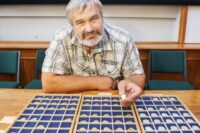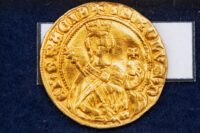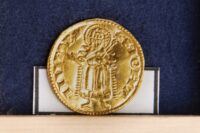 A hoard of 435 gold and silver coins from the 14th century was discovered by a couple on a walk in the woods near Kladruby Monastery in western Bohemia, Czech Republic. Well, technically, the hoard was discovered by a wild pig who started the excavation. The couple came across a two gold coins and one silver in the brush next to a large flat stone. When they lifted the stone, they saw there were many more coins underneath it. They reported the find to the Museum of West Bohemia in Plzeň and archaeologists unearthed the whole hoard.
A hoard of 435 gold and silver coins from the 14th century was discovered by a couple on a walk in the woods near Kladruby Monastery in western Bohemia, Czech Republic. Well, technically, the hoard was discovered by a wild pig who started the excavation. The couple came across a two gold coins and one silver in the brush next to a large flat stone. When they lifted the stone, they saw there were many more coins underneath it. They reported the find to the Museum of West Bohemia in Plzeň and archaeologists unearthed the whole hoard.
 There are 92 gold coins weighing a total of 326 grams and 343 silver coins in the hoard. The silver coins are of the groschen type which were common in Bohemia and central Europe in the 14th century. Most of the ones in the hoard were minted in Bohemia during the reign of Holy Roman Emperor Charles IV. They are very worn so must have been in wide circulation. The gold coins, on the other hand, are in excellent condition. They are ducats of Charles I of Hungary, of the Holy Roman Emperor Charles IV, of Albert III, Duke of Austria, and Rupert I, Elector Palatine and gold florins from Louis I of Hungary.
There are 92 gold coins weighing a total of 326 grams and 343 silver coins in the hoard. The silver coins are of the groschen type which were common in Bohemia and central Europe in the 14th century. Most of the ones in the hoard were minted in Bohemia during the reign of Holy Roman Emperor Charles IV. They are very worn so must have been in wide circulation. The gold coins, on the other hand, are in excellent condition. They are ducats of Charles I of Hungary, of the Holy Roman Emperor Charles IV, of Albert III, Duke of Austria, and Rupert I, Elector Palatine and gold florins from Louis I of Hungary.
Archaeologists believe the coins were buried in the ground in the late 1370s. While the reason why someone hid the treasure is likely to remain unknown, it was most likely linked to the nearby Monastery in Kladruby.
“The monastery was located on a strategic medieval trade route between Prague and Nürnberg. And since the discovery was made not far from there and close to the royal town of Stříbro, it is very likely that it is somehow connected to it.”
The Kladruby Monastery, a Benedictine abbey established by Vladislaus I, Duke of Bohemia, in 1115, was rich from the beginning, endowed with numerous properties and titles. Its wealth and power increased geometrically, peaking in the 14th century when the monastery’s income and territory were at royal levels. It had its own network of defensive castles on its feudal estates and was often mired in conflict with the nobility of the area.
 Because of the vast sums that flowed into the abbey’s coffers and its military power, the question of who would be appointed abbot was of enormous political import. This came to blows in 1396 when John of Nepomuk, vicar-general of the Archdiocese of Prague, appointed the candidate supported by his boss the archbishop and the Pope instead of the one selected by King Wenceslaus IV of Bohemia. The king had John tortured, thrown off a bridge and drowned. He was immediately revered as a martyr and canonized a saint.
Because of the vast sums that flowed into the abbey’s coffers and its military power, the question of who would be appointed abbot was of enormous political import. This came to blows in 1396 when John of Nepomuk, vicar-general of the Archdiocese of Prague, appointed the candidate supported by his boss the archbishop and the Pope instead of the one selected by King Wenceslaus IV of Bohemia. The king had John tortured, thrown off a bridge and drowned. He was immediately revered as a martyr and canonized a saint.
The coins are now being conserved and catalogued. They will go on display at the Museum of West Bohemia in Plzeň at the end of this year or the beginning of 2021.